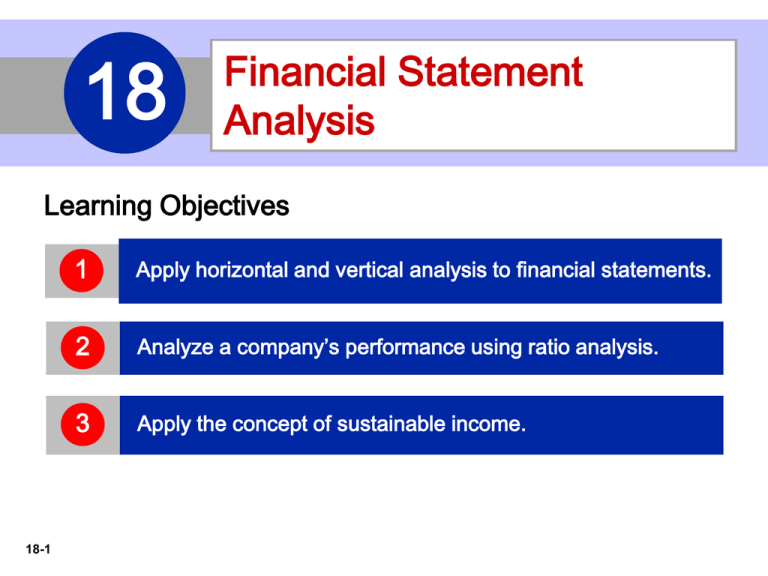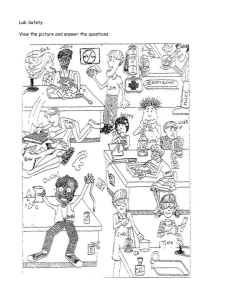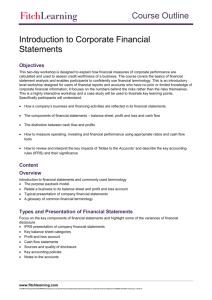
18
Financial Statement
Analysis
Learning Objectives
18-1
1
Apply horizontal and vertical analysis to financial statements.
2
Analyze a company’s performance using ratio analysis.
3
Apply the concept of sustainable income.
LEARNING
OBJECTIVE
1
Apply horizontal and vertical analysis to
financial statements.
Analyzing financial statements involves:
Comparison
Bases
Characteristics
Liquidity
Intracompany
Horizontal
Profitability
Vertical
Solvency
Industry
averages
Ratio
18-2
Tools of
Analysis
Intercompany
LO 1
Horizontal Analysis
Horizontal analysis, also called trend analysis, is a
technique for evaluating a series of financial statement data
over a period of time.
18-3
Purpose is to determine the increase or decrease.
Commonly applied to the
►
balance sheet,
►
income statement, and
►
statement of retained earnings.
LO 1
Horizontal Analysis
Illustration 18-5
Horizontal analysis of
balance sheets
Changes suggest that
the company expanded
its asset base during
2013 and financed this
expansion primarily by
retaining income rather
than assuming
additional long-term
debt.
18-4
LO 1
Horizontal Analysis
Illustration 18-6
Horizontal analysis of
Income statements
Overall, gross profit and
net income were up
substantially. Gross
profit increased
17.1%, and net income,
26.5%. Quality’s profit
trend appears
favorable.
18-5
LO 1
Horizontal Analysis
Illustration 18-7
Horizontal analysis of
retained earnings
statements
18-6
The ending retained earnings increased 38.6%. As
indicated earlier, the company retained a significant
portion of net income to finance additional plant facilities.
LO 1
Vertical Analysis
Vertical analysis, also called common-size analysis, is a
technique that expresses each financial statement item as a
percent of a base amount.
On an income statement, we might say that selling
expenses are 16% of net sales.
18-7
Vertical analysis is commonly applied to the
►
balance sheet and
►
income statement.
LO 1
Vertical Analysis
Illustration 18-8
Vertical analysis of
balance sheets
Quality is choosing to
finance its growth
through retention of
earnings rather than
through issuing
additional debt.
18-8
LO 1
Vertical Analysis
Illustration 18-9
Vertical analysis of
Income statements
Quality appears
to be a profitable
enterprise that is
becoming even more
successful.
18-9
LO 1
Vertical Analysis
Enables a comparison of companies of different sizes.
Illustration 18-10
Intercompany income statement comparison
18-10
LO 1
DO IT! 1
18-11
Horizontal Analysis
LO 1
LEARNING
OBJECTIVE
2
Analyze a company’s performance using ratio
analysis.
Ratio analysis expresses the relationship among selected
items of financial statement data.
Financial Ratio Classifications
18-12
Liquidity
Profitability
Solvency
Measures short-term
ability of the company
to pay its maturing
obligations and to
meet unexpected
needs for cash.
Measures the
income or operating
success of a
company for a given
period of time.
Measures the ability
of the company to
survive over a long
period of time.
LO 2
Ratio Analysis
A single ratio by itself is not very meaningful.
The discussion of ratios include the following types of
comparisons.
1. Intracompany comparisons for two years for Quality
Department Store.
2. Industry average comparisons based on median ratios
for department stores.
3. Intercompany comparisons based on Macy’s, Inc. as
Quality Department Store’s principal competitor.
18-13
LO 2
Ratio Analysis
Liquidity Ratios
Measure the short-term ability of the company to pay its
maturing obligations and to meet unexpected needs for
cash.
Short-term creditors such as bankers and suppliers are
particularly interested in assessing liquidity.
Ratios include the current ratio, the acid-test ratio,
accounts receivable turnover, and inventory turnover.
18-14
LO 2
QUALITY DEPARTMENT STORE INC.
Balance Sheet (partial)
2013
2012
QUALITY DEPARTMENT STORE INC.
Condensed Income Statements
For the Years Ended December 31
2013
2012
Illustration 18-12
18-15
LO 2
Ratio Analysis
Liquidity Ratios
1. CURRENT RATIO
2013
Illustration 18-12
2012
1.52:1
Ratio of 2.96:1 means that for every dollar of current liabilities, Quality
has $2.96 of current assets.
18-16
LO 2
Investor Insight
How to Manage the Current Ratio
The apparent simplicity of the current ratio can have real-world limitations
because adding equal amounts to both the numerator and the denominator
causes the ratio to decrease.
Assume, for example, that a company has $2,000,000 of current assets
and $1,000,000 of current liabilities. Thus, its current ratio is 2:1. If the
company purchases $1,000,000 of inventory on account, it will have
$3,000,000 of current assets and $2,000,000 of current liabilities. Its current
ratio therefore decreases to 1.5:1. If, instead, the company pays off
$500,000 of its current liabilities, it will have $1,500,000 of current assets
and $500,000 of current liabilities. Its current ratio then increases to 3:1.
Thus, any trend analysis should be done with care because the ratio is
susceptible to quick changes and is easily influenced by management.
18-17
LO 2
Ratio Analysis
Liquidity Ratios
2. ACID-TEST RATIO
Illustration 18-13
2013
18-18
2012
LO 2
QUALITY DEPARTMENT STORE INC.
Balance Sheet (partial)
2013
2012
QUALITY DEPARTMENT STORE INC.
Balance Sheet (partial)
2013
2012
Illustration 18-12
18-19
LO 2
Ratio Analysis
Liquidity Ratios
2. ACID-TEST RATIO
Illustration 18-14
2013
2012
0.47:1
Acid-test ratio measures immediate liquidity.
18-20
LO 2
QUALITY DEPARTMENT STORE INC.
Balance Sheet (partial)
2013
18-21
2012
QUALITY DEPARTMENT STORE INC.
Condensed Income Statements
For the Years Ended December 31
2013
2012
LO 2
Ratio Analysis
Liquidity Ratios
3. ACCOUNTS RECEIVABLE TURNOVER
Illustration 18-15
2013
2012
69.1 times
Measures the number of times, on average, the company collects
receivables during the period.
18-22
LO 2
Ratio Analysis
Liquidity Ratios
3. ACCOUNTS RECEIVABLE TURNOVER
$2,097,000
($180,000 + $230,000) / 2
= 10.2 times
A variant of the accounts receivable turnover ratio is to convert it
to an average collection period in terms of days.
365 days / 10.2 times = every 35.78 days
Accounts receivable are collected on average every 36 days.
18-23
LO 2
QUALITY DEPARTMENT STORE INC.
Balance Sheet (partial)
2013
2012
QUALITY DEPARTMENT STORE INC.
Condensed Income Statements
For the Years Ended December 31
2013
2012
Illustration 18-12
18-24
LO 2
Ratio Analysis
Liquidity Ratios
4. INVENTORY TURNOVER
2013
Illustration 18-16
2012
3.1 times
Measures the number of times, on average, the inventory is sold
during the period.
18-25
LO 2
Ratio Analysis
Liquidity Ratios
4. INVENTORY TURNOVER
$1,281,000
($500,000 + $620,000) / 2
= 2.3 times
A variant of inventory turnover is the days in inventory.
365 days / 2.3 times = every 159 days
Inventory turnover ratios vary considerably among industries.
18-26
LO 2
Ratio Analysis
Profitability Ratios
Measure the income or operating success of a company for a
given period of time.
Income affects the company’s ability to obtain debt and
equity financing, their liquidity position, and their ability to
grow.
Ratios include the profit margin, asset turnover, return on
assets, return on common stockholders’ equity, earnings
per share, price-earnings ratio, and payout ratio.
18-27
LO 2
QUALITY DEPARTMENT STORE INC.
Condensed Balance Sheets
2013
18-28
2012
QUALITY DEPARTMENT STORE INC.
Condensed Income Statements
For the Years Ended December 31
2013
2012
LO 2
Ratio Analysis
Profitability Ratios
5. PROFIT MARGIN
Illustration 18-17
2013
2012
5.3%
Measures the percentage of each dollar of sales that results in net
income.
18-29
LO 2
QUALITY DEPARTMENT STORE INC.
Condensed Balance Sheets
2013
2012
QUALITY DEPARTMENT STORE INC.
Condensed Income Statements
For the Years Ended December 31
2013
2012
Illustration 18-12
18-30
LO 2
Ratio Analysis
Profitability Ratios
6. ASSET TURNOVER
Illustration 18-18
2013
2012
1.3 times
Measures how efficiently a company uses its assets to generate
sales.
18-31
LO 2
QUALITY DEPARTMENT STORE INC.
Condensed Balance Sheets
2013
2012
QUALITY DEPARTMENT STORE INC.
Condensed Income Statements
For the Years Ended December 31
2013
2012
Illustration 18-12
18-32
LO 2
Ratio Analysis
Profitability Ratios
7. RETURN ON ASSETS
Illustration 18-19
2013
2012
7.0%
An overall measure of profitability.
18-33
LO 2
QUALITY DEPARTMENT STORE INC.
Condensed Balance Sheets
2013
2012
QUALITY DEPARTMENT STORE INC.
Condensed Income Statements
For the Years Ended December 31
2013
2012
Illustration 18-12
18-34
LO 2
Ratio Analysis
Profitability Ratios
8. RETURN ON COMMON STOCKHOLDERS’
EQUITY
Illustration 18-20
2013
2012
24.2%
Shows how many dollars of net income the company earned for each
dollar invested by the owners.
18-35
LO 2
Ratio Analysis
Profitability Ratios
8. RETURN ON COMMON STOCKHOLDERS’
EQUITY
With Preferred Stock
Deduct preferred dividend requirements from net income.
Illustration 18-21
Return on common stockholders’
equity with preferred stock
18-36
LO 2
QUALITY DEPARTMENT STORE INC.
Condensed Balance Sheets
2013
2012
QUALITY DEPARTMENT STORE INC.
Condensed Income Statements
For the Years Ended December 31
2013
2012
Illustration 18-12
18-37
LO 2
Ratio Analysis
Profitability Ratios
9. EARNINGS PER SHARE (EPS)
Illustration 18-22
2013
2012
A measure of the net income earned on each share of common stock.
18-38
LO 2
QUALITY DEPARTMENT STORE INC.
Condensed Balance Sheets
2013
2012
QUALITY DEPARTMENT STORE INC.
Condensed Income Statements
For the Years Ended December 31
2013
2012
Illustration 18-12
18-39
LO 2
Ratio Analysis
Profitability Ratios
10. PRICE-EARNINGS RATIO
Illustration 18-23
2013
2012
13.5 times
Reflects investors’ assessments of a company’s future earnings.
18-40
LO 2
QUALITY DEPARTMENT STORE INC.
Condensed Balance Sheets
2013
2012
QUALITY DEPARTMENT STORE INC.
Condensed Income Statements
For the Years Ended December 31
2013
2012
Illustration 18-12
18-41
LO 2
Ratio Analysis
Profitability Ratios
11. PAYOUT RATIO
Illustration 18-24
2013
2012
24.2%
Measures the percentage of earnings distributed in the form of cash
dividends.
18-42
LO 2
Ratio Analysis
Solvency Ratios
Solvency ratios measure the ability of a company to survive
over a long period of time.
Debt to Assets and
Times Interest Earned
are two ratios that provide information about debt-paying
ability.
18-43
LO 2
QUALITY DEPARTMENT STORE INC.
Condensed Balance Sheets
2013
2012
QUALITY DEPARTMENT STORE INC.
Condensed Income Statements
For the Years Ended December 31
2013
2012
Illustration 18-12
18-44
LO 2
Ratio Analysis
Solvency Ratios
12. DEBT TO TOTAL ASSETS RATIO
Illustration 18-25
2013
2012
71.1%
Measures the percentage of the total assets that creditors provide.
18-45
LO 2
QUALITY DEPARTMENT STORE INC.
Condensed Balance Sheets
2013
2012
QUALITY DEPARTMENT STORE INC.
Condensed Income Statements
For the Years Ended December 31
2013
2012
Illustration 18-12
18-46
LO 2
Ratio Analysis
13. TIMES INTEREST EARNED
Solvency Ratios
Illustration 18-26
Provides an indication of the company’s
ability to meet interest payments as they
come due.
18-47
LO 2
Ratio Analysis
Summary of Ratios
Illustration 18-27
18-48
LO 2
Summary of Ratios
Illustration 18-27
18-49
LO 2
LEARNING
OBJECTIVE
3
Apply the concept of sustainable income.
Sustainable income is the most likely level of income to be
obtained by a company in the future. It differs from actual net
income by the amount of unusual revenues, expenses, gains,
and losses included in the current year’s income.
Information on unusual items such as gains or losses on
discontinued items and components of other comprehensive
income are disclosed.
These unusual items are reported net of income taxes.
18-50
LO 3
Discontinued Operations
(a) Disposal of a significant component of a business.
(b) Report the income (loss) from discontinued operations
in two parts:
1. income (loss) from operations (net of tax) and
2. gain (loss) on disposal (net of tax).
18-51
LO 3
Discontinued Operations
Illustration: During 2017 AE Inc. has income before income
taxes of $79,000,000. During 2017, AE Inc. discontinued and
sold its unprofitable chemical division. The loss in 2017 from
chemical operations (net of $135,000 taxes) was $315,000.
The loss on disposal of the chemical division (net of $81,000
taxes) was $189,000. Assuming a 30% tax rate on income.
Show how this discontinued operation would be presented on
the income statement.
18-52
LO 3
Discontinued Operations
Income Statement (in thousands)
Discontinued Operations
are reported after
“Income from continuing
operations.”
Previously labeled as
“Net Income”.
Moved to
18-53
Sales
Cost of goods sold
$ 285,000
149,000
Other revenue (expense):
Interest revenue
17,000
Interest expense
(21,000)
Total other
(4,000)
Income before taxes
79,000
Income tax expense
24,000
Income from continuing operations
55,000
Discontinued operations:
Loss from operations, net of tax
315
Loss on disposal, net of tax
189
Total loss on discontinued operations
504
Net income
$ 54,496
LO 3
Other Comprehensive Income
All changes in stockholders’
equity except those resulting
from investments by
stockholders and distributions
to stockholders.
Income Statement (in thousands)
Sales
Cost of goods sold
Gross profit
Operating expenses:
Advertising expense
Depreciation expense
Total operating expense
Income from operations
Other revenue:
Interest revenue
Total other
Income before taxes
Income tax expense
Net income
18-54
$ 285,000
149,000
136,000
10,000
43,000
53,000
83,000
17,000
17,000
100,000
24,000
$ 76,000
Reported in
Stockholders’ Equity
+
Unrealized gains and
losses on available-forsale securities.
Plus other items
LO 3
Other Comprehensive Income
Illustration: During 2017 Stassi Company purchased IBM stock for
$10,000 as an investment. At the end of 2017, Stassi was still holding
the investment, but the stock’s market price was now $8,000. In this
case, Stassi is required to reduce the recorded value of its IBM
investment by $2,000. The $2,000 difference is an unrealized loss.
Should Stassi include this $2,000 unrealized loss in net income? It
depends on whether Stassi classifies the IBM stock as a trading
security or an available-for-sale security.
Trading securities: Unrealized gains and losses are reported in the
“Other expenses and losses” section of the income statement.
Available-for-sale securities: Unrealized gains and losses are reported
as a direct adjustment to stockholders’ equity.
18-55
LO 3
Other Comprehensive Income
Assume Stassi Company classifies their investment in IBM stock as
available-for-sale.
Illustration 18-30
Lower portion of statement of
comprehensive income
18-56
LO 3
Other Comprehensive Income
Assume Stassi Corporation has common stock of $3,000,000,
retained earnings of $1,500,000, and an unrealized loss on availablefor-sale securities of $2,000. Illustration 18-31 shows the balance
sheet presentation of the unrealized loss.
Illustration 18-31
Unrealized loss in stockholders’ equity section
18-57
LO 3
Illustration 18-32
Complete statement of
comprehensive income
18-58
LO 3
DO IT! 3
Unusual Items
In its proposed 2017 income statement, AIR Corporation
reports income before income taxes $400,000, unrealized gain
on available-for-sale securities $100,000, income taxes
$120,000 (not including unusual items), loss from operation of
discontinued flower division $50,000, and loss on disposal of
discontinued flower division $90,000. The income tax rate is
30%.
Prepare a correct statement of comprehensive income,
beginning with “Income before income taxes.”
18-59
LO 3
DO IT! 3
18-60
Unusual Items
LO 3
A Look at IFRS
LEARNING
OBJECTIVE
4
Compare financial statement analysis and income
statement presentation under GAAP and IFRS.
Relevant Facts
The tools of financial statement analysis covered in this chapter are
universal and therefore no significant differences exist in the
analysis methods used.
The basic objectives of the income statement are the same under
both GAAP and IFRS. A very important objective is to ensure that
users of the income statement can evaluate the sustainable income
of the company.
18-61
LO 4
A Look at IFRS
Relevant Facts
The basic accounting for discontinued operations is the same
under IFRS and GAAP.
The accounting for changes in accounting principles and changes
in accounting estimates are the same for both GAAP and IFRS.
Both GAAP and IFRS follow the same approach in reporting
comprehensive income.
18-62
LO 4
A Look at IFRS
Looking to the Future
The FASB and the IASB are working on a project that would rework the
structure of financial statements. Recently, the IASB decided to require
a statement of comprehensive income, similar to what was required
under GAAP.
18-63
LO 4
A Look at IFRS
IFRS Self-Test Questions
The basic tools of financial analysis are the same under both GAAP and
IFRS except that:
18-64
a)
horizontal analysis cannot be done because the format of the
statements is sometimes different.
b)
analysis is different because vertical analysis cannot be done
under IFRS.
c)
the current ratio cannot be computed because current liabilities
are often reported before current assets in IFRS statements of
position.
d)
None of the above.
LO 4
A Look at IFRS
IFRS Self-Test Questions
Presentation of comprehensive income must be reported
under IFRS in:
a) the statement of stockholders’ equity.
b) the income statement ending with net income.
c) the notes to the financial statements.
d) a statement of comprehensive income.
18-65
LO 4
A Look at IFRS
IFRS Self-Test Questions
In preparing its income statement for 2017, Parmalane assembles the following
information.
Sales revenue
Cost of goods sold
Operating expenses
Loss on discontinued operations
$500,000
300,000
40,000
20,000
Ignoring income taxes, what is Parmalane’s income from continuing operations
for 2017 under IFRS?
(a) $260,000.
(b) $250,000.
(c) $240,000.
(d) $160,000.
18-66
LO 4
Copyright
“Copyright © 2015 John Wiley & Sons, Inc. All rights reserved.
Reproduction or translation of this work beyond that permitted in
Section 117 of the 1976 United States Copyright Act without the
express written permission of the copyright owner is unlawful.
Request for further information should be addressed to the
Permissions Department, John Wiley & Sons, Inc. The purchaser
may make back-up copies for his/her own use only and not for
distribution or resale. The Publisher assumes no responsibility for
errors, omissions, or damages, caused by the use of these programs
or from the use of the information contained herein.”
18-67






